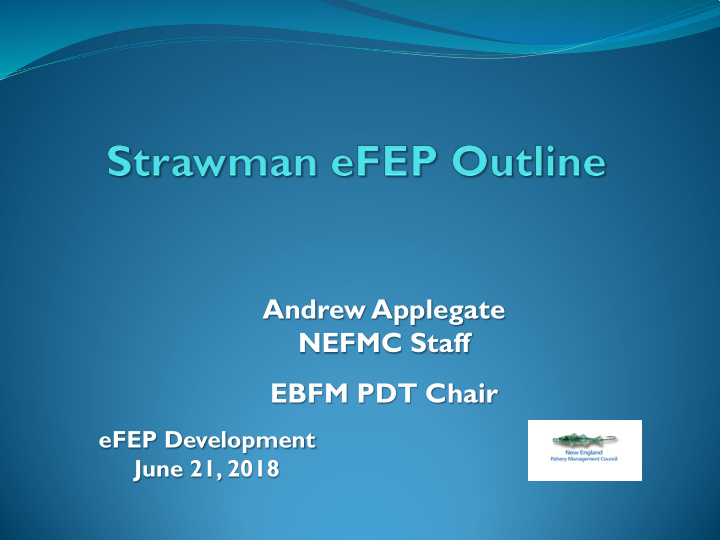



Andrew Applegate NEFMC Staff EBFM PDT Chair eFEP Development June 21, 2018
EBFM Committee Agenda June 21, 2018 Hilton Garden Inn, Boston, MA EBFM Plan Development Team report Provide feedback on an initial draft “Ecosystem Risk Assessment for the Georges Bank Ecosystem Production Unit” Discuss the “2018 Ecosystem-Based Fishery Management Strategy Independent Peer Review” Report Receive a report about a draft “Northeast Regional Implementation Plan of NOAA Fisheries Ecosystem-Based Fisheries Management Roadmap” Discuss a draft strawman outline of an example prototype Fishery Ecosystem Plan (eFEP) Identification of tasks and timeline to complete an eFEP 2
NEFMC Approach To prepare: 1. A policy describing goals and objectives, and approaches, for taking account of ecosystem processes in fishery management, and 2. An example of a fishery ecosystem plan that is based on fundamental properties of ecosystem (e.g., energy flow and predator/prey interactions) as well as being realistic enough and with enough specification such that it could be implemented. The example should not be unduly constrained by current perceptions about legal restrictions or policies. 3
NEFMC Approach The Council is pursuing a fundamentally different EBFM approach relative to other Fishery Management Councils and management authorities. Unlike other EBFM approaches, the NEFMC is focused on place-based management and trophic guilds (i.e., energy production units) as management units rather than managing fish stocks using independent harvest control rules. The new approach addresses the implications of both biological interactions (i.e., predator/prey) and fishery interactions (bycatch and mix species fisheries). 4
NEFMC Process 3. With respect to number 2, it is understood that the example might not be implemented, but it should make clear what a fishery ecosystem plan would actually entail and it should focus debate. 5
NEFMC EBFM Development Process Don’t design solution without understanding the problem Phase I Decide on application (EBFM with eFEP, EAFM, Omnibus, FMP) Phase II Develop example Fishery Ecosystem Plan (eFEP) Phase III Management Strategy Evaluation - testing, verification, engage public (scoping) Phase IV Develop alternatives for final FEP Implement plan and make adjustments as Phase V needed 6
DRAFT prototype Fishery Ecosystem Plan Problem statement MSY consistent with ecosystem productivity Often no allocation for species caught Complex regulations Usually no consideration of ecosystem demand Gaps in data and monitoring across FMPs 8
DRAFT prototype Fishery Ecosystem Plan Vision statement Consideration of broader objectives and benefits Accounting for trophic interactions Simplified regulations Reduce discards Increase opportunities for fishermen Ensure sustainability of fish and non-fish marine resources Promote sustainable fishing communities Avoid implementation costs and scientific uncertainty associated with single species management 9
DRAFT prototype Fishery Ecosystem Plan Key features Dynamic and flexible approach EPU MSY based on sum of MSY for species complexes, subject to limits of primary productivity (ceilings). Stock complexes Reference points (ceilings) Similar trophic and life history characteristics Catch limits harmonious with role in the ecosystem Objectives to serve multiple needs Production of economic value Sustenance of fishing communities Support of fish, birds, sea turtles, and marine mammals at higher trophic levels 10
Fishery Ecosystem Plan Key features Protections against excessive depletion of stocks (floors) Thresholds that vary in consideration of stock vulnerability to fishing, resilience, and role in the ecosystem Rebuilding plans for overfished stocks Special catch limits T echnical measures Catch limits allocated to functional groups – stock complexes caught together in a fishery (gear, area, etc). Equivalent to Sub-Annual Catch Limits (ACL) with Accountability Measures when the stock complex ACL is exceeded Vessels permitted on the basis of a fishery (gear, area), instead of a species Greater use of data sources and ecosystem monitoring 11
Fishery Ecosystem Plan Components Objectives – Strategic and Tactical Scope – area, fisheries, managed stocks Ecosystem MSY Biological reference points and Harvest control rules Stock complexes, recognizing trophic interactions Assessments & indicators Status determinations Overfishing stock complexes Overfished stocks and rebuilding 12
Fishery Ecosystem Plan Components Fishing Access and Permitting Catch Allocation Functional group allocations Vessels in a fishery having allocations of one or more Georges Bank functional groups Recreational catch allocations Spatial management measures for habitat, spawning, and endangered/threatened species protection Unmanaged and invasive species policies Technical measures (e.g. mesh, area, seasons, size limits) 13
Fishery Ecosystem Plan Components Decision support Advisory Teams Data collection, monitoring, and fishery research Integrated Ecosystem Assessment Ecosystem Risk Assessment Management Strategy Evaluation Transition strategy to place-based FEP Jurisdiction, cooperation, and collaboration 14
Recommend
More recommend